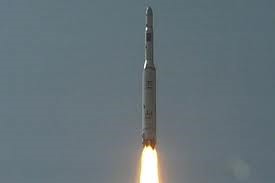 Fifteen years after its first attempt to launch a satellite mounted on an indigenous rocket, North Korea's successful launch of the Unha-3 satellite launch vehicle on Wednesday demonstrated an ability to overcome the challenges of three-stage rocket technology, at least once. The event was a small but significant step for North Korea's weapons development program. More significant, however, are its possible political implications.
Fifteen years after its first attempt to launch a satellite mounted on an indigenous rocket, North Korea's successful launch of the Unha-3 satellite launch vehicle on Wednesday demonstrated an ability to overcome the challenges of three-stage rocket technology, at least once. The event was a small but significant step for North Korea's weapons development program. More significant, however, are its possible political implications.
The Unha-3 (also known as the Taepodong, after the location of North Korea's first launch facility) has an estimated range of between 10,000 and 13,000 kilometers (roughly 6,200 to 8,000 miles). The rocket's reach, coupled with its polar launch trajectory, gives Pyongyang at least a rudimentary ability to target the United States with a ballistic missile. Considering North Korea's previous nuclear tests, Pyongyang is signaling that it has a new deterrent capability: a possible retaliatory nuclear strike on the United States.
Currently, this threat is more political than military and will remain so for the foreseeable future. The ability to carry out an underground nuclear test is not the same as the ability to build a nuclear bomb or a nuclear warhead small and robust enough to mount on a long-range missile. North Korea's successful launch involved only a basic capability, not the ability to reliably repeat a three-stage rocket launch. The country also has yet to exhibit the capability to develop and deploy the re-entry technology needed for the delivery of a long-range missile warhead. And although the North managed to partially obscure the exact launch time and date of the rocket, the nature of the Unha system makes strategic surprise almost impossible. South Korean, Japanese and U.S. anti-missile systems had little problem tracking the launch from its start. The launch was an important technological development for North Korea, but the country still has a long way to go to develop a credible nuclear deterrent.
However, the political implications of Wednesday's launch were indeed significant. From Pyongyang's perspective, the ambiguity of its weapons development program has always been valuable, since it has kept the program below a level that could provoke pre-emptive foreign military intervention. For example, while North Korea has carried out two nuclear tests, it has not demonstrated nuclear weapons capability. While it has launched a satellite weighing 100 kilograms (roughly 220 pounds), the country has not demonstrated long-range ballistic missile capability. Even in its more actively deployed missile systems such as the Nodong, the North has conducted few tests, leaving a fog of uncertainty around the systems' range and accuracy, limiting analysis to interpolations based on assessments of similar foreign missiles (some of which were designed with North Korean involvement). What Pyongyang has created is the sense of a nuclear deterrent against the United States without the real risk of a U.S. military response.
This gives the North a sense of confidence and a little more space to maneuver diplomatically. While North Korea already has a large conventional deterrence against U.S. and South Korean military action, Pyongyang's primary counter to the United States is China. Yet, even more than the United States, China itself poses the biggest strategic threat to North Korea, not because Beijing is considering invading the North or even cutting off economic assistance and trade. Rather, Pyongyang has grown increasingly dependent on China for the North's survival -- economically, politically and militarily -- reducing Pyongyang's sense of independence. By demonstrating a nascent ability to threaten the U.S. mainland -- not just U.S. forces in South Korea or Japan -- Pyongyang has reduced ever-so-slightly its political and defense dependence on China.
After North Korea's first satellite launch attempt in 1998, the country accepted a brief period of heightened international isolation before going on a global diplomatic offensive, establishing ties with several Western nations and facilitating the first-ever visit by a sitting South Korean president to the North. In many ways, Pyongyang is hoping for a repeat of this pattern after this week's launch. The North feels slightly more confident, the reality of the launch cannot be undone, and now the government can wait a few months before engaging in discussions with Japan, the United States and South Korea.
Pyongyang sees the likelihood of right-leaning governments taking power in Tokyo and Seoul as working to its advantage, since offers to improve political relations can be better managed by these governments than by left-leaning governments, which would likely be accused of appeasement and undermining national security. North Korea is also looking at Washington's relationship with Myanmar as a potential model for future relations with the United States, albeit one fraught with domestic U.S. political challenges. But by successfully demonstrating its space launch capability, the North does not need to test again anytime soon. It can offer space program cooperation (by, say, letting other countries launch its satellites) and another moratorium on testing in exchange for progress in replacing the 1953 Armistice Agreement with a formal peace accord.
This, of course, is only North Korea's intent. There is no guarantee that Pyongyang's plans will be successful abroad, and the country could face domestic challenges as well. But the successful launch in the face of international pressure, isolation and condemnation has strengthened Kim Jong Un's standing in the North, giving him more room to explore adjustments to North Korea's domestic, economic and foreign policy strategies. And the ambiguity of its deterrent capability gives the North a sense of additional security, something that could make it more bold in its international relations, and, thus, in its attempts to reduce its overdependence on the Chinese.
Courtesy : Stratfor (www.stratfor.com)